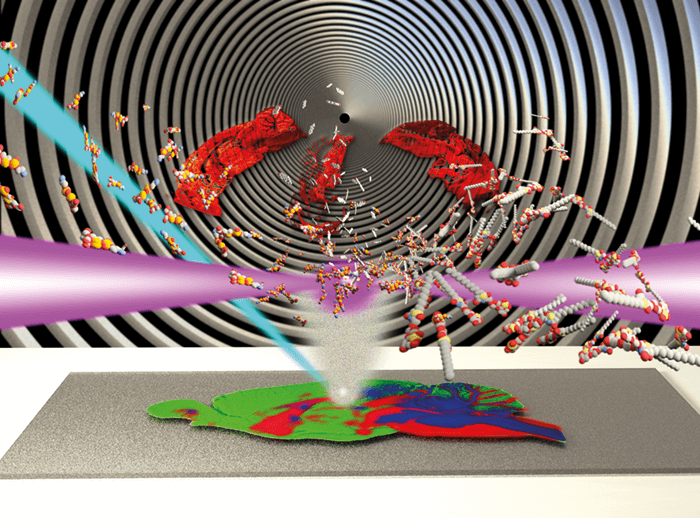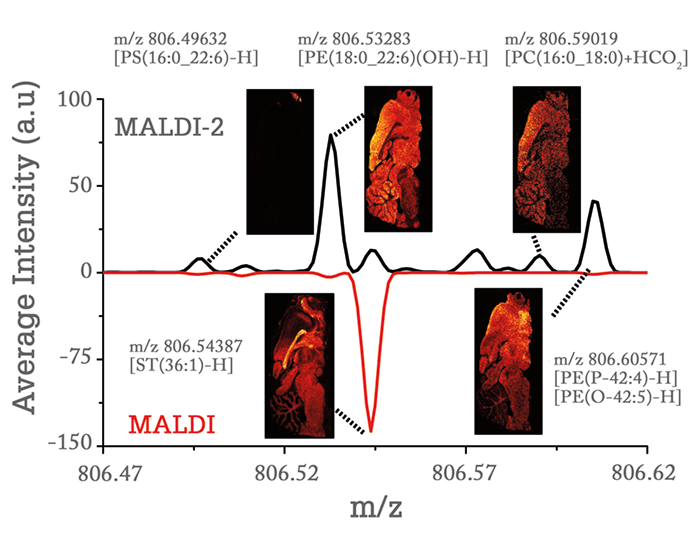
What is the aim of your research?
My group develops new instrumental methods and applications to improve the chemical information we can extract from imaging data. I have a strong focus on lipids, and find it fascinating that in almost every tissue studied with MSI, a heterogeneous spatial distribution of lipids is seen, and yet the underlying reasons behind these distributions are not known. More generally, very little is known about the roles of individual lipids in cell metabolism and function – I want to add to our knowledge.
How are you improving MSI?
As a chemist, I want to know exactly what molecules we are seeing in MSI, but this goal is complicated by the presence of isomers. We are combining new MS/MS methods (such as selective gas phase ion/molecule reactions) with imaging, to resolve structural isomers and discover exactly what molecules are contributing to a signal. By breaking down an image into the isomeric contributors, we can begin to understand the biochemical origin of MSI data. By combining this with the power of high-mass–resolving-power MSI using FT-based analyzers to reduce the search space for structural assignments, we would one day like to gain a cell-by-cell view of all active metabolic processes and how they are altered with disease. We are also working on adding temporal data to MSI. With MSI, we acquire a static snapshot of a heterogeneous sample – but in reality, the molecules we detect are the result of a variety of dynamic processes. To capture this change over time, we are infusing isotope labels into animals so that we can monitor uptake of the isotope label into biochemical processes. This means we can directly view the turnover and synthesis of new molecules, and differentiate new molecules (synthesized since label introduction) from old molecules (synthesized before label introduction). This provides a powerful and as yet largely untapped resource to image the kinetics of biochemical conversions within tissues. Speed is also very important, especially for clinical applications of MSI. Modern time-of-flight (ToF) systems allow us to acquire data up to 20 times faster than a few years ago, but these methods are now at the physical limits of conventional ToF technology. M4I is heavily involved with the Medipix consortium at CERN, working on semi-conductor-based detectors for stigmatic imaging. With the Timepix detector and dedicated ion optics within stigmatic imaging mass spectrometers, we can acquire thousands of pixels in parallel (rather than one at a time). Instead of one detector we have 262,144 detectors, each capable of recording both ToF and impact position (1)(2)(3).
What’s next?
The typically low ionization efficiencies of many molecules mean that we may only detect one in every 10,000-1,000,000 occurrences of a given molecule – this is the ultimate limitation in sensitivity. Work is ongoing at M4I and elsewhere to finally overcome this key challenge, either using targeted derivatization methods to convert certain molecules into more detectable forms (for example by adding a fixed charge), or using the MALDI-2 method, where a second laser is fired into the MALDI plume. Pioneering work by the University of Muenster (4) and later by M4I (5) has shown this method can enable up to two orders of magnitude greater sensitivity for certain molecules and significantly improves the depth of molecular coverage for an MSI experiment (see Figure 1). I also think the use of MS/MS methods (both conventional and new variants) will continue to gain momentum, moving towards true molecular identification of signals observed in MSI. High mass resolution has been a huge advance, but ultimately this provides little structural information beyond elemental composition. For structure determination, MS/MS is needed. The challenge is that MS/MS is typically a targeted approach, and it’s not yet clear how best to combine this with the untargeted nature of MSI.References
- SR Ellis et al., Angew Chem Int Ed, 52, 11261–11264 (2013). S Ellis, J Soltwisch, RA Heeren, Am Soc Mass Spectrom, 25, 809–819 (2014). J Soltwisch et al., Anal Chem, 86, 321–325 (2013). J Soltwisch et al., Science, 348, 211–215 (2015). S Ellis et al., Chem Commun, 53, 7246–7249 (2017).




